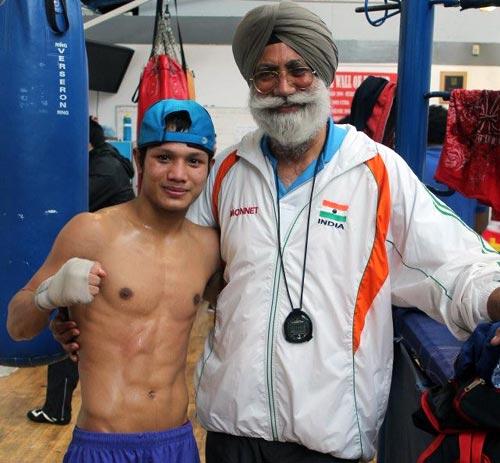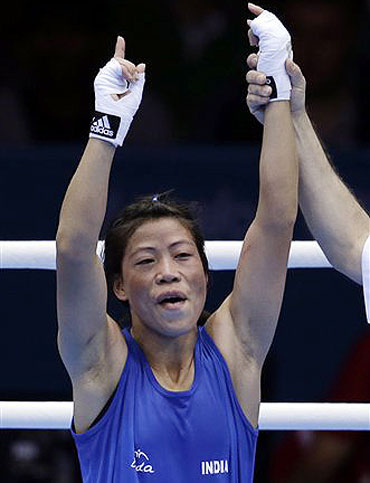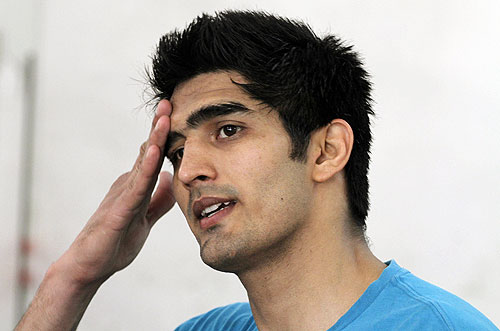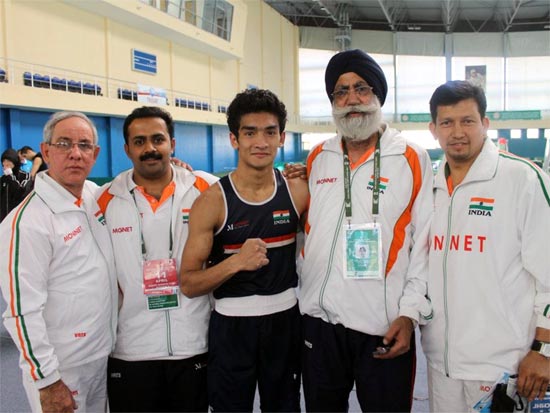Photographs: Hari Shankar Varma (Physiotherapist - Indian national boxing team) Sumit Bhattacharya
At a time when Indian boxing is on an unprecedented high, a book captures the history and essence of the sport in the country, finds Sumit Bhattacharya.
M C Mary Kom, the five times world champion in women's boxing -- an Olympic sport from this year -- was told she was 'too small, too frail and too young' to start training as a boxer. As she sat crying in a corner of the boxing coaching centre in Imphal, the capital of Manipur, the coach asked her why she would not go. She said the next bus to her village was after three days. The coach took pity and thought he would let the little girl train till then...
Bangalore-based sports journalist Shamya Dasgupta's book Bhiwani Junction: The Untold Story of Boxing in India (HarperCollins India) is filled with many such moments. You will know that G S Sandhu, India's chief boxing coach, has turned up at exactly 6:30 am to train the country's boxers -- for nearly three decades. That Muslim girls in Kolkata's dockyard areas are taking up boxing as a sport as a 'jihad' against community conventions. That three Indo-Canadians, Sardar Balwant Singh, Sardar Ajmer Singh and Sardar Baldev Singh, have been sponsoring sports including soccer and boxing in Chakari, Punjab, transforming the kids of the village.
The book is light on its feet and spars, sportingly and relentlessly, with the people it profiles. No one is a god here, everyone has feet of red tape. And though it is named after the Haryana town that has thrown up most of India's ring heroes -- including the brightest star, Vijender Singh, Olympic bronze medalist -- you don't have to be a boxing buff to enjoy the breezily-written book.
Special: The untold story of Indian boxing
Image: Mary KomPhotographs: AP Photo/Mike Groll
Boxing is part of the what's right in India story. But you don't spare the punches in your book. How do you see the future of Indian boxing if, say, this contingent comes back empty-handed from London? In other words, is the new high sustainable?
Interesting question, and, honestly, I haven't considered that, so convinced I am that this contingent, including M C Mary Kom, will win around three medals in London. Having said that, I am fairly sure that the high will be sustained. There is no reason for the enthusiasm for the sport dying down in Haryana, which has emerged as the centre of excellence for boxing, as well as other Olympic sports, in recent years.
We have always had good boxers. Of late, we have had world-class boxers. That's because of a combination of factors, like the emergence of talented athletes, improved facilities especially in Haryana, and, crucially, tremendous support from the Haryana government.
In the London contingent, we have Vikas Krishan, Sumit Sangwan, Shiva Thapa, Devendro Singh and Manoj Kumar, who are all in their early 20s. Even Vijender Singh, the veteran, is in his late 20s. So if, as you say, the boxers come back empty-handed from London, it will be a disappointment, but won't change the fact that within the next few years, India could be one of the superpowers in the amateur boxing arena.Special: The untold story of Indian boxing
Photographs: Parivartan Sharma/Reuters
How long did the book take? What surprised you in the research?
A fair bit of the book talks about my experiences at boxing centres and venues around the country and in Beijing 2008. I wrote a very long article for the International Journal of the History of Sport on the history of Indian boxing in the mid-2000s sometime. All of it came in handy, though very little of it was connected directly with the subject matter of the book, so I had to do quite a bit of the research and conduct many interviews afresh, depending on the flow of the book. So, while writing the book itself took around three-four months, the research of it was carried out, inadvertently, over a decade or so.
What surprised me -- honestly, not much. I knew the story I was going out to tell. Yes, there were things that threw me off, especially the candour with which someone like Akhil Kumar spoke, some of the data I dug up from the Indian Boxing Federation offices, etc. But, on the whole, not much.Special: The untold story of Indian boxing
Image: (Left to right): Blas Fernandez, Hari Shankar Varma, Shiva Thapa, Gurbax Singh Sandhu, Jaidev BishtPhotographs: Hari Shankar Varma (Physiotherapist - Indian national boxing team)
What ails sport in India?
I will list out the following. India's failure to inculcate a sporting culture in the country; which school takes sport seriously and makes it part of the curriculum in a serious way? The traditional career choices remain the career choices for youngsters.
The fact that only people from the lower financial classes take up Olympic sport -- except tennis and shooting, which are for the financially better off. People take up sport to land government jobs, which are available on the 'sports quota'. As a result, once that job is secured, the athletes don't need to do more -- the end objective has been achieved.
Complete lack of support from the government -- states or Central. I will never say that education or medicine is less important than sport -- though, in an ideal world, defence would be below sport -- but our financial outlay for sport has traditionally been pathetic. And even if money has been disbursed, which is the case for the elite athletes of the country -- where that money goes is anybody's guess. Strong policies have been missing.
Politics, used loosely, at every level ensures that sports, and sportspersons, are made to struggle for basic requirements and facilities. I hate the fact that I have backed the Haryana government so much in the book as well as in my articles in the media, but their role has been exemplary. I wish other states could, and would, do the same.




Comment
article